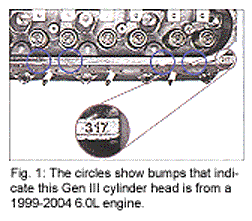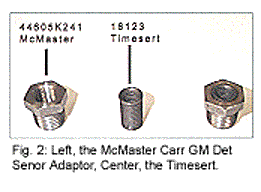Back a couple of hundred years ago, some brilliant thinkers believed that the bumps on your head could be used to diagnose your health or predict personality traits. Using the psuedo-science “Phrenology,” advocates would feel your scalp and tell you if you were a genius or a criminal (please, no amateur diagnoses based on the picture above).
Though it was finally universally accepted that such practices were, in fact, a bunch of hooey, reading the bumps on heads may soon make a comeback, at least in this industry, thanks to General Motors.
We have already had a number of articles looking at the GM Gen III engine, focusing on crankshafts, major components and the spark controller reluctor ring. This month’s information is one of the more intricate, insider type pieces of information that you rarely see unless you operate at the OE level.

As it turns out there are bumps on the outer perimeter of the rocker cover rail, but only on the exhaust side of the cylinder head. Even though this is a center bolt rocker cover cylinder head the bumps give the impression of an edge bolt cover, only without the bolthole drilled and tapped (Figure 1).
Well, those bumps mean something. As you can see there are four of them with a distinctive gap between the first two and the last two.
As explained in Chart 1, GM cast a series of bumps on the Gen III heads – so they can be used as identifiers. The center two on this c/n 317 cylinder head are missing. If you look at the chart, you’ll see this identifies this cylinder head as a 6.0L used from 2001-2004 and it should have four bumps, the first two and the last two. You will also see that the only cast iron cylinder head had no bumps at all.
Take specific note of the 6.0L Natural Gas engine application cylinder heads. They used unique valve seat inserts and Stellite face valves. When c/n 317 is used for this application it will have the No. 5 position bump machined off. You will want to watch for this if you have both types of engines in the same location because you don’t want to get the heads mixed up. You could end up with CNG head on a gasoline engine and lose valuable cores, or put gasoline heads on a CNG engine and have the potential of severe exhaust valve recession and loss of cylinder compression at the least or dropping a valve at the worst. Either way you have a chargeable warranty, which has a horrible impact on your profits.
One last tidbit; In January’s “Core Corner”, I wrote about sensor adaptors for Ford and GM engines. I have two updates to that article, including a correction. For the Chevrolet block I explained about making your own adaptor to create a universal block. The pipe plug size listed was 3/8″ NPT when it is actually 1/4″ NPT.

Next, see Figure 2 for the “buy it” adaptor version. The larger piece that has the hex head on it for easy installation and removal is available from McMaster Carr, a national industrial supplier. The other is the familiar Timesert. Use the Timesert tap, run it through the adaptor, install the Timesert and you’re done.
I will be in Las Vegas during the last weekend in April, at the PERA Spring Technical and Marketing Program. Check out the meeting information at www.pera.org. and maybe I’ll see you there. I will also be talking about EngineDataSource.com during AERA Expo in Booth 704 at the Las Vegas Convention Center, so please come by and say hello.
I look forward to talking to you and trying to help you solve your engine building mysteries. And I promise I won’t read the bumps on your head to do so.
For technical questions, contact the Production Engine Remanufacturers Association (PERA) at: [email protected]













